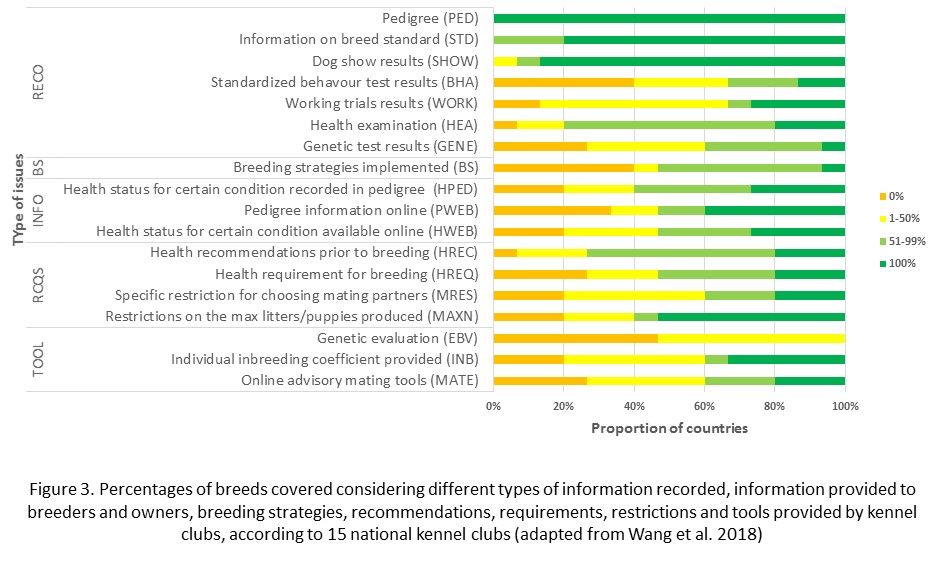Breeding policies and management of pedigree dogs in 15 national kennel clubs
National Kennel Clubs are major stakeholders in the governance and regulation of dog breeding. As such, they have been the targets of major criticism related to dog health issues. It is therefore interesting to investigate to what extent health and welfare is a priority for kennel clubs (KCs), and what are the capacities and actions implemented to deal with those issues.
A survey was sent in 2017 to 40 KCs with 15 answers received from 11 European (Austria, Belgium, Denmark, France, Germany, Ireland, Latvia, The Netherlands, Norway, Sweden and the UK) and 4 non-European countries (Australia, Mexico, Uruguay, and the USA) aimed at describing and comparing information across countries in dog breed health management (Wang et al. 2018).
First, in order to determine the population of dogs under the responsibility of KC, the percentages of all dogs being registered as ‘pedigree’ dogs were estimated considering the 15 surveyed KCs, as well 35 other countries, using sources such as the FCI online statistics. Across countries, the average and median percentage of the entire dog population that were registered pedigree dogs, respectively was 20% and 14%. However, there was a large variation across countries, with European Nordic countries showing, in general, a larger proportion of pedigree dogs (see Figure 1). This aspect is of importance, since it is expected that the responsibility toward general dog health, as well as the capacity to improve the situation, relates to the proportion of dogs that are at least to some extent under the influence of the KCs.

When asked about the current challenges, KCs ranked exaggerated morphological features and inherited disorders as the most important issues, showing those two problems are now clearly identified as priorities (Figure 2). By contrast, issues such as economic constraints to breeding were rarely viewed as problematic for dog breeding. Kennel clubs also commented on challenges related to the difficulty to find balance between increased regulation and the risk of losing members; to achieve consensus and compliance of breeders and clubs toward breed health strategies; as well as lack of capacity regarding information provision and education.

Surveyed countries showed great diversity in terms of information management, implementation of breeding strategies, recommendations, requirement, restriction and tools. Most KCs indicated that information on genealogies, breed standards and dog shows were recorded in their data base for most, if not all breeds; however, health information (e.g. screening examinations, genetic tests) was more sparsely recorded and provided to the public, both for breeds within countries and across countries (Figure 3). For instance, KCs from Austria, Australia, Denmark, France, Germany, The Netherlands, Norway, the UK and the USA provided health information status on pedigrees and in online data bases, but in general, not all breeds were covered. When considering implementation of breeding strategies, six countries indicated that there were no breeding strategies implemented by any breed clubs, while in three countries (Austria, Sweden and the Netherlands) it was reported that each breed club had its breeding strategy.

Several countries indicated that they were planning to develop breeding tools and provide health information to users, and for instance, France and Belgium reported having ongoing work to develop tools to provide online pedigree with health information or estimate breeding values for complex disorders such as hip dysplasia.
Although limited by the relatively low number of countries considered, this survey showed that despite large differences in their approach to breeding policies and management, the awareness to improve breeding and health of pedigree dogs was strong among the surveyed Kennel Clubs. The dog breeding world is increasingly global in scope. The understanding of both the diversity of health initiatives and the potential for coordinated actions internationally is key to further efforts to promote dog health and welfare.
There is probably still a lot of progress to be made in term of information provision and collection, as well as planning breeding strategies considering dog health. In particular, finding a consensus in terms of constraints and priorities for breeding, is expected to be particularly challenging for Kennel Clubs and breed clubs in order to implement those strategies. Although the situations differ across countries, exchanges of experiences may surely help to find the most adequate solutions toward improvement of health and welfare.
Reference:
Wang, S., Laloë, D., Missant, F. M., Malm, S., Lewis, T., Verrier, E., ... & Leroy, G. (2018). Breeding policies and management of pedigree dogs in 15 national kennel clubs. The Veterinary Journal. https://doi.org/10.1016/j.tvjl.2018.02.018
 Donate
Donate
3 Comments
Recommended Comments